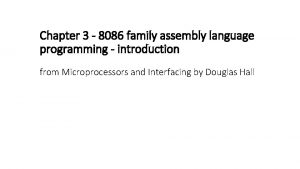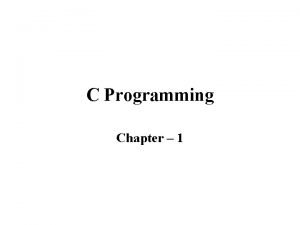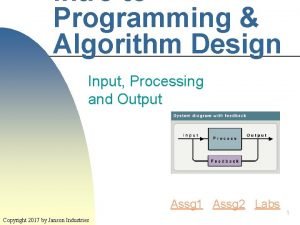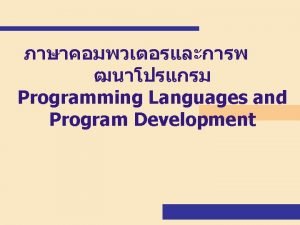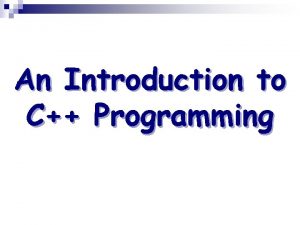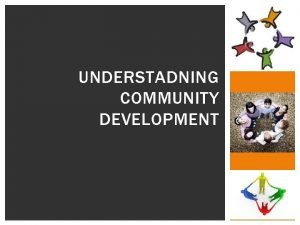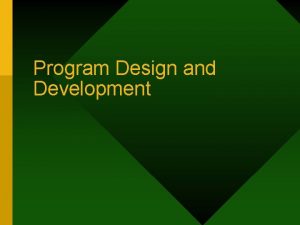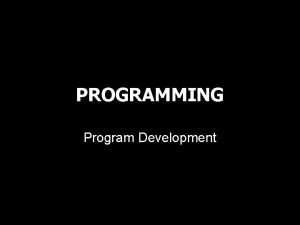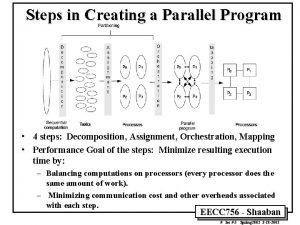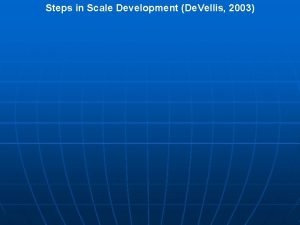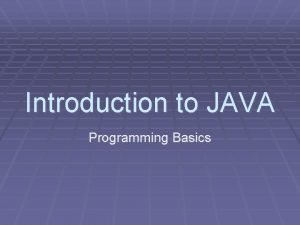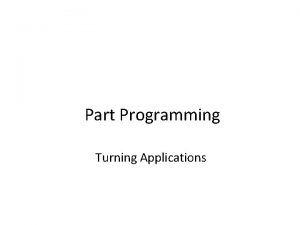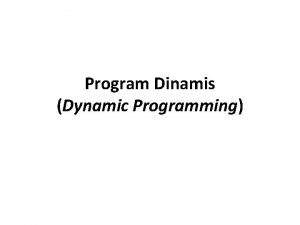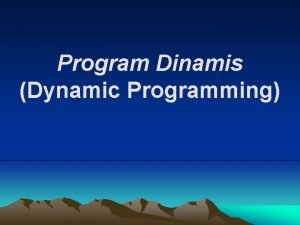C Programming Chapter 1 Steps In Program Development















- Slides: 15

C Programming Chapter – 1

Steps In Program Development • • • Start Problem Identification Task Analysis Data Analysis Deciding Output & Inputs Development of Algorithm Program Coding Program Testing Program Implementing Stop

Program Language Classification • Machine Language • Assembly Language • Procedure oriented language(High Level Language) • Fourth Generation Language(4 GLs)

Program Language Classification

Machine Language • The lowest-level programming language • Machine languages are the only languages understood by computers. • While easily understood by computers, machine languages are almost impossible for humans to use because they consist entirely of numbers

Assembly Language • Assembly languages have the same structure and set of commands as machine languages, but they enable a programmer to use names instead of numbers.

High Level Language • A programming language such as C, FORTRAN, or Pascal that enables a programmer to write programs. • The main advantage of high-level languages over low-level languages is that they are easier to read, write, and maintain.

Fourth Generation Language(4 GLs) • Often abbreviated 4 GL, fourthgeneration languages are programming languages closer to human languages than typical highlevel programming languages. Most 4 GLs are used to access databases.

Generations of Computer Languages • First Generation: machine language • Second Generation: assembly language • Third Generation: high-level programming languages, such as C, C++, and Java. • Fifth Generation: languages used for artificial intelligence and neural networks.

Language Translator • Translator is defined as a computer program that converts instructions written in one language to another without changing the initial logic in terms of computer language. • There are two types of translator – Compiler – Interpreters

Compiler Vs Interpreter • A compiler first takes in the entire program, checks for errors, compiles it and then executes it. • Whereas, an interpreter does this line by line, so it takes one line, checks it for errors and then executes it.

Programming Technique • There are three programming techniques commonly used. – Top-down design – Bottom-up design – Modular design

Top-Down design Vs Bottom-Up Top-down Approach Bottom-up Approach It starts by identifying the major components of the system, decomposing them into their lower-level components and iterating until the desired level of detail is achieved. It starts with designing the most basic or primitive components and proceeds to higher-level components that use these lower-level components. It starts from the highest level component of the hierarchy and proceeds to lower levels. It starts with the lowest level component of the hierarchy and proceeds through progressively higher levels. It is suitable only if the specifications are clearly known. It is suitable if a system is to be built from an existing system.

Modular design • Modular programming is a programming which large programming is divide into small module to solve problem is called modular programming

Chapter – 1 End
 8086 program development steps
8086 program development steps Language translator
Language translator Perbedaan linear programming dan integer programming
Perbedaan linear programming dan integer programming Greedy programming vs dynamic programming
Greedy programming vs dynamic programming What is system programming
What is system programming Linear vs integer programming
Linear vs integer programming Perbedaan linear programming dan integer programming
Perbedaan linear programming dan integer programming Dynamic programming
Dynamic programming Flowgorit
Flowgorit Programming process steps
Programming process steps Programming process steps
Programming process steps Programming process steps
Programming process steps Meaning of axial movement
Meaning of axial movement Be next frontier software development
Be next frontier software development First stage in community development process
First stage in community development process Various steps involved in portfolio development
Various steps involved in portfolio development
